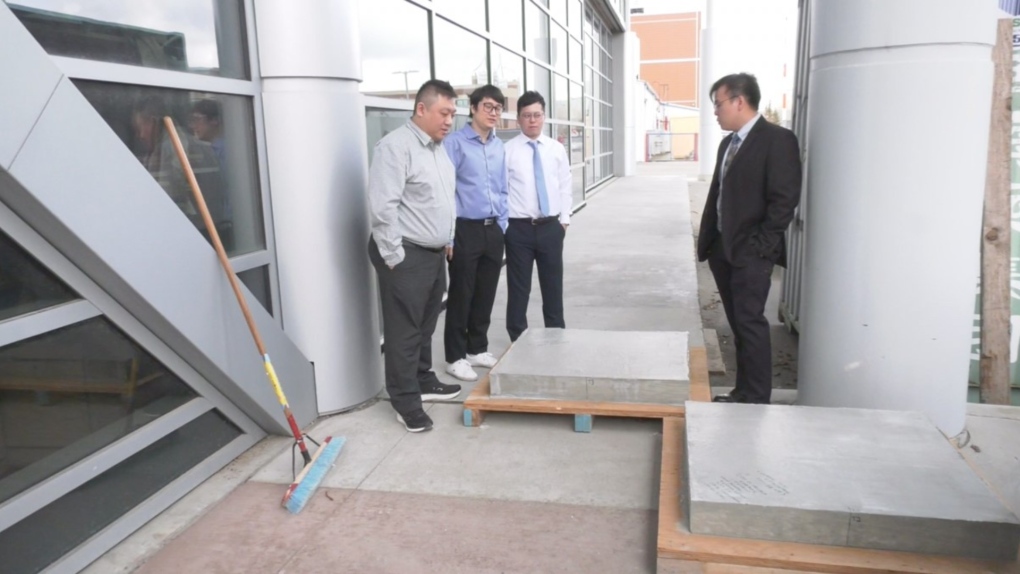SAIT students may have found a way to combat Calgary’s cracked sidewalks
SAIT students in the Civil Engineering Technology program believe they have created the right mix of concrete and graphene to combat the city’s growing sidewalk problem, due to freeze-thaw cycles.
“Yesterday was, what? 20 C. It’s going to probably snow tonight or tomorrow. That really affects our sidewalks, with the soil base underneath, to cause all these cracks and fractures,” said student Derrick Leung, who started the project with three of his classmates.
“So with graphene, it’s supposed to make it more durable, more flexible than conventional crushed concrete.”
Graphene is extracted from graphite and is made up of pure carbon, which is strong, flexible and has high resistance.
Leung, along with Tony Ly, Pinyo Sirisettanan and Chi Kin Wong, began researching the benefits of graphene in concrete before doing a lab test.
The hope is to save money and reduce the city’s carbon footprint.
As part of their capstone project, the students poured two concrete slabs in February, one with graphene and one without, to compare the differences.
It turns out the one with graphene made the concrete stronger.
“We applied our theory to potentially make it stronger. The increase in strength could also reduce the amount of cement used, so there was a sustainability components added on top of that.”
Ly says the group worked with several industry partners, including the City of Calgary, on what is expected each time a sidewalk is poured.
“There’s a lot of sidewalks in the City of Calgary, so even if you’re saving, these are not the exact numbers, but even if you’re saving five per cent on costs, and you multiply it by all the sidewalks that we do in Calgary, that adds up,” he said.
“That’s a lot of like public funds that could be used in other aspects.”
 SAIT students Derrick Leung, Tony Ly, Pinyo Sirisettanan and Chi Kin Wong believe they have created the right mix of concrete and graphene to combat Calgary’s cracked sidewalks. Rick Duchscher is the Connector Lead in the Connector Lab at SAIT, where the students did much of the work on the project.
SAIT students Derrick Leung, Tony Ly, Pinyo Sirisettanan and Chi Kin Wong believe they have created the right mix of concrete and graphene to combat Calgary’s cracked sidewalks. Rick Duchscher is the Connector Lead in the Connector Lab at SAIT, where the students did much of the work on the project.
“It’s very much like a library where we’re not tied to any particular program or course,” said Duchscher.
“If a student has an assignment or a project that they need some assistance with, they will come here and we will help them connect with all kinds of different resources.”
The City of Calgary spends between $12 million and $15 million on repairs and replacement of concrete infrastructure as part of the city’s annual sidewalk programs.
“The city continues to work with SAIT students on potential commercial usage of graphene in city sidewalks,” read a statement from Chris McGeachy with the city’s mobility department.
“The city continues to evaluate viability, performance and cost effectiveness of this project, which currently resides at SAIT. We look forward to continuing to provide industry expertise as we work with these students.”
The city says it has not made a decision to introduce graphene into future concrete mixes just yet, but says there are benefits.
“The overall goal of the project is to reduce carbon through concrete mix design, and at the same time, make sidewalks more resilient to changes in climate,” said McGeachy.
“In recent years, the city has also increased the use of green (low carbon) cement, aligning with construction industry’s standards to adopt sustainable materials which provide equivalent or better performance while reducing environmental impacts.”
The students will present their project on April 26.
View original article here Source









